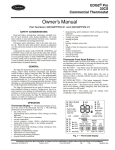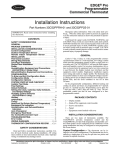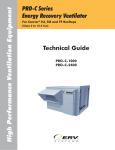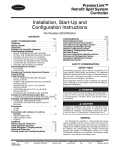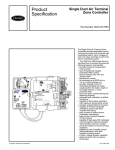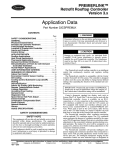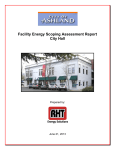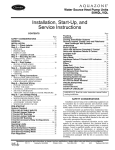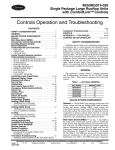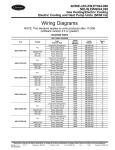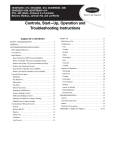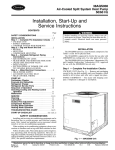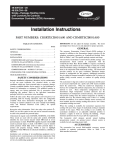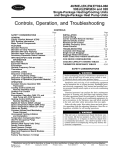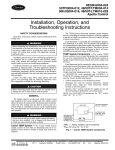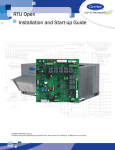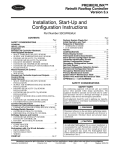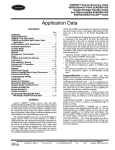Download Carrier 48EZ(N)-A Instruction manual
Transcript
EDGE® Pro Programmable Commercial Thermostat Installation Instructions Part Numbers 33CS2PPRH-03 and 33CS2PP2S-03 IMPORTANT: Read entire instruction before installing the thermostat. CONTENTS SAFETY CONSIDERATIONS . . . . . . . . . . . . . . . . . . . . . . 1 GENERAL . . . . . . . . . . . . . . . . . . . . . . . . . . . . . . . . . . . . . . . . 1 PACKAGE CONTENTS . . . . . . . . . . . . . . . . . . . . . . . . . . . 1 INSTALLATION CONSIDERATIONS . . . . . . . . . . . . . .1,2 Control Configuration . . . . . . . . . . . . . . . . . . . . . . . . . . . . 1 Outdoor Temperature Sensor . . . . . . . . . . . . . . . . . . . . 2 Remote Indoor Temperature Sensor. . . . . . . . . . . . 2 INSTALLATION . . . . . . . . . . . . . . . . . . . . . . . . . . . . . . . . . 2-6 Thermostat Location . . . . . . . . . . . . . . . . . . . . . . . . . . . . . 2 Wiring Requirements. . . . . . . . . . . . . . . . . . . . . . . . . . . . . 2 Two-Piece Installation . . . . . . . . . . . . . . . . . . . . . . . . . . . . 2 Single-Piece Installation . . . . . . . . . . . . . . . . . . . . . . . . . 5 Power . . . . . . . . . . . . . . . . . . . . . . . . . . . . . . . . . . . . . . . . . . . . 6 Humidification Equipment and Connections (33CS2PPRH-03 Model Only). . . . . . . . . . . . . . . . . . . . 6 Dehumidification Equipment and Connections . . . 6 CONFIGURATION . . . . . . . . . . . . . . . . . . . . . . . . . . . . . .6-11 To Enter and Exit Configuration Mode. . . . . . . . . . . . 6 Configuration Mode . . . . . . . . . . . . . . . . . . . . . . . . . . . . . . 6 Configuration Options . . . . . . . . . . . . . . . . . . . . . . . . . . . 7 SYSTEM START-UP AND CHECKOUT . . . . . . . . .11,12 Installer Test Mode . . . . . . . . . . . . . . . . . . . . . . . . . . . . . . 11 Default Schedule . . . . . . . . . . . . . . . . . . . . . . . . . . . . . . . . 11 Setting the Clock, Calendar, Daily Schedule, and Holiday Settings . . . . . . . . . . . . . . . . . . . . . . . . . . . 11 Humidity Control Features (33CS2PPRH-03 Model Only). . . . . . . . . . . . . . . . . . . 11 Holiday. . . . . . . . . . . . . . . . . . . . . . . . . . . . . . . . . . . . . . . . . . 12 OPERATION . . . . . . . . . . . . . . . . . . . . . . . . . . . . . . . . . . .12,13 Unoccupied Overrride. . . . . . . . . . . . . . . . . . . . . . . . . . . 12 Timers . . . . . . . . . . . . . . . . . . . . . . . . . . . . . . . . . . . . . . . . . . 13 Heat/Cool Set Points (Desired Temperature). . . . . 13 Equipment On Indicators. . . . . . . . . . . . . . . . . . . . . . . . 13 Humidification and Dehumidification Indicators . . . . . . . . . . . . . . . . . . . . . . . . . . . . . . . . . . . . . . 13 Hybrid Heat® Dual-Fuel System Operation . . . . . . 13 Auto Changeover . . . . . . . . . . . . . . . . . . . . . . . . . . . . . . . 13 Emergency Heat Mode . . . . . . . . . . . . . . . . . . . . . . . . . . 13 Dry Contact/Economizer Output . . . . . . . . . . . . . . . . 13 TROUBLESHOOTING. . . . . . . . . . . . . . . . . . . . . . . . . .13,14 Error Codes . . . . . . . . . . . . . . . . . . . . . . . . . . . . . . . . . . . . . 14 WIRING DIAGRAMS . . . . . . . . . . . . . . . . . . . . . . . . . . 14-25 THERMOSTAT CONFIGURATION RECORD . . . . CL-1 SAFETY CONSIDERATIONS Read and follow manufacturer instructions carefully. Follow all local electrical codes during installation. All wiring must conform to local and national electrical codes. Improper wiring or installation may damage sensor. Recognize safety information. This is the safety alert symbol . When the safety alert symbol is present on equipment or in the instruction manual, be alert to the potential for personal injury. Understand the signal words DANGER, WARNING, and CAUTION. These words are used with the safety alert symbol. DANGER identifies the most serious hazards which will result in severe personal injury or death. WARNING signifies a hazard which could result in personal injury or death. CAUTION is used to identify unsafe practices which would result in minor personal injury or property damage. GENERAL Carrier’s 7-day, 5/2-day, or 1-day programmable commercial thermostat control is a wall-mounted, low-voltage control which provides temperature control in either a single unit or a two-piece unit. The 33CS2PPRH-03 thermostat will provide both temperature and humidity control. In the two-piece configuration, the relays are located near the equipment and a twowire connection is used between the display module (DM, the user interface) and the equipment control module (ECM). Single-piece installation requires more wiring and results in a higher profile. The thermostat needs no batteries to store userconfigured settings in memory. If power is lost, the internal memory saves settings for unlimited time and the clock continues to run for at least 24 hours. In the programmable configuration, different heating and cooling set points and times are programmable for 4 periods per day or 2 periods per day. Programming can be done for 7 days per week, 5 and 2 days per week, or 1 day. The programmable control can also be user-configured as a nonprogrammable control. PACKAGE CONTENTS 1 — Display module 1 — Stand-off for equipment control module 2 — Screws and anchors 1 — Pigtail 1 — Equipment control module with cover INSTALLATION CONSIDERATIONS There are two types of thermostats available. The 33CS2PP2S-03 thermostat provides temperature control and the 33CS2PPRH-03 thermostat provides both temperature and humidity control. Both models can be configured for air conditioner or heat pump installations and may be configured as non-programmable, if desired. Control Configuration — The thermostat can be in- stalled in one of two configurations. The thermostat may be installed as a single piece or it may be split into two pieces and mounted in separate locations. Manufacturer reserves the right to discontinue, or change at any time, specifications or designs without notice and without incurring obligations. Catalog No. 04-53330026-01 Printed in U.S.A. Form 33CS-74SI Pg 1 6-13 Replaces: 33CS-66SI • As a single-piece unit, all required wiring must be brought to the ECM for connection to the terminal strip. In two-piece configuration, the DM can be mounted in the space while the ECM may be mounted near the equipment, always within the building space and not outdoors. Connection from the DM to the ECM requires only two wires. All other control wires are connected to the ECM from the HVAC (heating, ventilation, and air conditioning) equipment. This configuration results in a slimmer profile and locates the ECM containing the switching relays away from the occupied space so relay clicking will not be heard. Installer should determine whether control will be installed as single-piece or two-piece. In single-piece configuration, as many as 14 wires may need to run to wall mounting location for connection to the control. In two-piece configuration, the DM and ECM are connected by two wires. • where humidity operating range is within 0 to 95% relative humidity, non-condensing always secured to the wall with wire nuts The thermostat should NOT be mounted: close to a window, on an outside wall, or next to a door leading to the outside • where exposed to direct light and heat or any other temperature-radiating object which may cause false readings • close to or in direct airflow from supply registers or return air grille in areas with poor air circulation • outside of the building exposed to the elements • Wiring Requirements • All system wiring must be in compliance with all applicable local and national codes. • All sensor wiring should be color coded in conformance with the standard recommendations. • Never remove the thermostat board from the plastic housing. Doing so could warp and damage the components on the board. • The sensor wiring must be completely separated from the thermostat or any other control wiring and must not be in the same conduit as high voltage wiring. Refer to the sensor documentation for specific wiring instructions. • Wiring specifications from the thermostat to the sensor are 22 AWG (American Wire Gage) unshielded for a distance of less than 100 ft. It is recommended for lengths greater than 100 ft to use shielded 22 AWG wire for increased noise immunity. Wire length should not exceed 1,000 ft. • For wiring the control module to the equipment, the distance should be no more than 100 ft when using 22 AWG wire, and no more than 300 ft when using 18 AWG wire. The rule is the same for wiring the control module to the display module: no more than 100 ft when using 22 AWG wire, and no more than 300 ft when using 18 AWG wire. Outdoor Temperature Sensor — The outdoor air temperature sensor is not included with the thermostat. It is available as an accessory (part no. 33ZCSENOAT). Plan installation so that 2 wires can be run from equipment control module to an outdoor location, preferably on the north side of the building or refer to Installation Instructions included with the outdoor temperature sensor for simplified connection. Details are provided in sensor instructions. Remote Indoor Temperature Sensor — A remote temperature sensor can be used where it is desirable to install the control in a limited access location while measuring the temperature in the space. The remote sensor can be used as a stand-alone device or averaged with a local sensor(s). NOTE: Carrier sensor part no. 33ZCT55SPT would be used for remote space sensing averaging. Sensors must be used as a single sensor, 4 sensors, or 9 sensors, with total sensor wiring not to exceed 1,000 ft. The 33ZCSENSAT sensor would be used for supply and return sensing. INSTALLATION Two-Piece Installation — For two-piece installation, perform the following procedure. 1. Turn off all power to equipment. 2. If an existing thermostat is being replaced: a. Remove existing control from wall. b. Disconnect wires from existing thermostat, one at a time. As each wire is disconnected, record the wire color and terminal marking. c. New or additional wires may be needed to accommodate added humidity outputs. d. Discard or recycle old control. 3. Remove mounting plate from back of display module by pressing the two tabs on the bottom edge and pulling away. See Fig. 1. Figure 2 shows the mounting plate removed from the module. 4. Route wires through large hole in mounting base. Level mounting base against wall (for aesthetic purposes only, the display module does not need to be leveled for proper operation) and mark wall through 2 mounting holes. See Fig. 3. 5. Drill two 3/16-in. mounting holes in the wall where marked. The control module may be mounted to a standard junction box, if desired. Make sure the hole pattern on the control module mounting base matches the junction box mounting holes. CAUTION Failure to follow the recommended wiring practices could result in damage to the thermostat and/or property. CAUTION Mount the ECM (equipment control module) in a suitable indoor location, either near or on the indoor equipment. The ECM should not be mounted to indoor ductwork or below any other controls or equipment (for example, a humidistat or humidifier). Failure to follow this practice could result in damage to equipment and/or property. Thermostat Location — The thermostat should be mounted: • approximately 5 ft from the floor • close to or in a frequently used space, preferably on an inside wall • on a section of wall without pipes or ductwork • where temperature operating limits are within –67 to 257 F (–55 to 125 C) 2 6. During thermostat installation provide sufficient excess wiring behind the mounting plate. Coil the wiring creating a service loop and place in mounting box or behind the wall to remove strain against the terminal strip. See Fig. 4. a33-9162 Fig. 1 — Locking Tab Location Fig. 4 — Coil Excess Wiring 7. Secure rear plastic mounting base to wall with 2 screws and anchors provided. Additional mounting holes are available for more secure mounting if needed. Make sure all wires extend through hole in mounting base. 8. Adjust length and routing of each wire to reach proper connector block and terminal on mounting base with extra 1/ -in. wire. 4 9. Connect two wires from the equipment control module to the display module mounting base, being careful not to over-tighten the screws. Correct polarity must be observed when connecting the two wires. If wires are connected incorrectly, the display module will not operate. See Fig. 5 and 6. a33-9163 Fig. 2 — Mounting Plate Removed a33-9164 a33-9165 Fig. 3 — Mounting Plate Installation Fig. 5 — Backplate Connector Terminals 3 14. Find a suitable indoor mounting location for equipment control module. The module should be mounted on or near the HVAC equipment. See Fig. 8. a33-9166 Fig. 6 — Pigtail Connection Fig. 8 — Equipment Control Module Mounting 10. Connect red wire of the pigtail to V+ RED terminal. Connect black wire of the pigtail to Vg BLACK terminal. NOTE: The 2-wire pigtail is not intended to support the weight of the display module. Do not hang the user interface from the equipment control module screw terminals. 11. Seal hole in wall to prevent air leaks. Leaks can affect operation and cause incorrect temperature and/or humidity measurement. 12. Attach 2-wire pigtail to display module. Pigtail is packed loose in the box from the factory. Pigtail is attached to the back of the display module via 2-pin, keyed connector. 13. Reattach display module body to mounting base by first setting the module on at top of mounting base and then snapping the bottom corners of display module into place. See Fig. 7. 15. Route wires through rear of equipment control module using either a clearance hole or supplied standoff. See Fig. 9. Standoff is provided as an aid when installing equipment control module on equipment or a solid wall. NOTE: The equipment control module should not be mounted to ductwork or below any other controls or equipment (i.e., humidistat, humidifier, etc.). Fig. 9 — Standoff Installed on Equipment Control Module 16. Match and connect equipment wires to proper terminals of each connector block, being careful not to over tighten the screws. Correct polarity must be observed when connecting the two wires from the equipment control module to the display module mounting base. If wires are connected incorrectly, the display module will not operate. See Fig. 10. 17. Snap cover over top of equipment control module. See Fig. 11. 18. Turn on power to equipment. On power up, all display segments will light for 5 seconds. For the next 5 seconds, a 2digit code will appear on the center of the large display which identifies the equipment configuration: AC — Two-stage heat / Two-stage cool HP — Three-stage heat / Two-stage cool Fig. 7 — Display Module Installation 4 RELAYS DRY CONTACT CONNECT TO USER INTERFACE JW6 TWIST OFF OAT/RRS RETURN Rc Rh W1 G Y2 C O/W2/B Y1 OAT RRS SRTN HUM D1 D2 RED V+ BLACK Vg SEPARATE RC/RH BY BREAKING JW6 ON CONTROL MODULE BOARD. a33-9170 OAT RRS LEGEND — Outdoor Air Temperature Sensor — Remote Room Temperature Sensor Fig. 10 — Control Module Connector Block Terminals only, the equipment control module does not need to be leveled for proper operation) and mark wall through two mounting holes. 5. Drill two 3/16-in. mounting holes in wall where marked. The equipment control module may be mounted on the junction box, if desired. Make sure that the hole pattern on base matches junction box mounting holes. 6. During thermostat installation provide sufficient excess wiring behind the mounting plate. Coil the wiring creating a service loop and place in mounting box or behind the wall to remove strain against the terminal strip. See Fig. 4 on page 3. 7. Secure base to wall with two screws and anchors provided. Additional mounting holes are available for more secure mounting if needed. Make sure that all wires extend through hole in mounting base. 8. Adjust length and routing of each wire to reach proper connector block and terminal on mounting base with extra 1/ -in. wire. 4 9. Connect equipment wiring to the terminals on the equipment control module, being careful not to over-tighten the screws. See Fig. 10. 10. Seal hole in wall to prevent air leaks. Leaks can affect operation and cause incorrect temperature and/or humidity measurement. 11. Connect red wire of the pigtail to V+ terminal on the equipment control board. Pigtail is packed loose in the box from the factory. Pigtail is attached to the back of the display module via 2-pin, keyed connector. Connect black wire of the pigtail to Vg terminal on the equipment control board. Correct polarity must be observed when connecting. If wires are connected incorrectly, the display module will not operate. NOTE: The 2-wire pigtail is not intended to support the weight of the user interface. Do not hang the display module from the equipment control module screw terminals. 12. Attach 2-wire pigtail to display module. Fig. 11 — Cover Installed on Equipment Control Module Single-Piece Installation — For single-piece installa- tion, perform the following procedure. 1. Turn off all power to equipment. 2. If an existing thermostat is being replaced: a. Remove existing control from wall. b. Disconnect wires from existing thermostat, one at a time. c. As each wire is disconnected, record wire color and terminal marking. d. New or additional wires may be needed to accommodate added humidity outputs. e. Discard or recycle old control. 3. Remove cover from equipment control module by pressing the two tabs on the bottom edge and pulling away. 4. Route wires through large hole in equipment control module base. Level base against the wall (for aesthetic purposes 5 13. Attach display module body to equipment control module by first setting the module on at top of equipment control module and then snapping the bottom corners of display module into place. 14. Turn on power to equipment. On power up, all display segments will light for 5 seconds. For the next 5 seconds, a 2-digit code will appear on the center of the large display which identifies the equipment configuration: AC — Two-stage heat / Two-stage cool HP — Three-stage heat / Two-stage cool CONFIGURATION To Enter and Exit Configuration Mode — Press and hold OCCUPIED button for approximately 10 seconds. The display module will now be in Configuration mode. The module will automatically exit this mode if no button is pressed for 3 minutes. Pressing the DONE button will exit Configuration mode immediately. Configuration Mode — The option number is dis- played in the heat set point location and the configuration setting is displayed in the cool set point location. A box will surround the option number. The MODE button is used to move the box between the two displayed values or the soft keys below the values may also be used. The value inside the box is changed by using the UP and DOWN buttons. All changes made are saved at the time of selection and will be saved in the event of the 3-minute timeout or when installer exits from configuration menu. See Table 1. Power — The thermostat is powered by 24 vac only. The thermostat requires the 24 vac (Rh and/or Rc and C terminals) of the low-voltage transformer to be connected to it for proper operation. The thermostat will not operate without these connections. The Rh and Rc terminals are connected via the PCB breakout jumper. For applications using a single 24-vac transformer for power, the breakout jumper should remain intact. For applications using two 24-vac transformers, the breakout jumper must be broken because possible voltage differences between the two transformers could cause irregular operation or damage to the thermostat. See Fig. 12. For applications using two 24-vac transformers, one in the indoor unit and one in the outdoor unit, connect the common wire from each to the C terminal. Connect R from the indoor unit to the Rh terminal. Connect R from the outdoor unit to the Rc terminal. Break the jumper on the circuit board. See Fig. 12. The W and HUM signals are taken from the Rh power and the G signal is taken from the Rc power. If the control has been installed in a two-transformer application that is later changed to a single-transformer installation, the installer must install a field-supplied jumper between Rc and Rh. Depending on the installation, up to 14 wires may be required. Installation as two-piece unit is recommended. Only two wires are required for connection between display module and equipment control module. These two wires (V+ and Vg) do not provide ordinary 24 vac. They carry a combination of power and communications data that is unique to these products. Table 1 — Configuration Options OPTION NO. 01 02 03* 04 05 06 07 08 09 10 11 12 13 14 15 16 17 18* 19 20 21* 22 23 24* 25* 26 27 28 29 30 31* 32 33 34 35 36 37 38 39 99 a33-9172 Fig. 12 — PCB Breakout Jumper Humidification Equipment and Connections (33CS2PPRH-03 Model Only) — The humidification output connects directly to 24-vac operated humidifiers. No other connection or interlock is required. Any of several installer-selectable operating modes are available. WARNING DO NOT connect unit HUM terminal directly to thermostat control HUM terminal. This will bypass unit safety controls. Personal injury or death could result. Dehumidification Equipment and Connections — The D1 and D2 terminals are for a dry relay con- tact. Operating the relay by itself will not cause 24 V to appear at the terminal. To have 24 V appear at D2, D1 has to have a wire jumper added to either Rc or Rh. The dry contact must be configured for dehumidification in configuration Option 19. See page 8. See Wiring Diagrams for more information. DDC SAT OAT UV CONFIGURATION Equipment Type Replace Filter Reminder Fahrenheit/Centigrade Selection Fan (G) on with W/W1 Selection Space Temperature Sensing Cooling Lockout Equipment DDC Controller Auxiliary Heat Lockout Temperature Setting Heat Pump Lockout Temperature Reversing Valve Adjustable Set Point Deadband Smart Recovery Space Temperature Offset Adjustment Humidity Offset Adjustment Enable Auto Mode Cycles Per Hour Time Between Stages Backlight Configuration Dry Contact Outdoor Air Temperature Offset Adjustment Keypad Lockout High Cool Latch Temperature High Heat Latch Temperature Programmable/Non-Programmable Number of Programmable Periods per Day Minimum Cooling Set Point Maximum Heating Set Point UV Light Reminder Service Reminder Unused Daylight Savings Time Configuration Unused Single or Two-Piece Installation OAT/SRTN Terminals for OAT or SAT Sensor Emergency Heat Mode Availability Fan Selection During Occupied Periods Fan Selection During Unoccupied Periods Maximum Temporary Hold For Hours Temperature Display Reset to Factory Defaults LEGEND — Direct Digital Controller — Supply-Air Temperature — Outdoor-Air Temperature — Ultraviolet * These settings are accessible by the user from the display without entering Configuration mode. 6 55 F (–15, –12.2, –9.4, –6.7, –3.9, –1.1, 1.7, 4.4, 7.2, 10 or 12.8 C). When set to OF (off), the function is disabled. Auxiliary heat is allowed to operate whenever sufficient demand for heat is available. When set to 5 through 55 F (–15 through 12.8 C), this is the outdoor temperature above which the auxiliary heat is not allowed to operate. The default is OF (off). OPTION 09 — HEAT PUMP LOCKOUT TEMPERATURE — This function is only available on hybrid heat systems that have a valid outdoor temperature sensor connected. Configuration options are Off, 5, 10, 15, 20, 25, 30, 35, 40, 45, 50 or 55 F (–15, –12.2, –9.4, –6.7, –3.9, –1.1, 1.7, 4.4, 7.2, 10 or 12.8 C). When set to Off, the heating equipment cycle will always start with the heat pump regardless of the outdoor-air temperature. When set to 5 through 55 F (–15 through 12.8 C), and the outdoor-air temperature is less than the selected temperature, the heating cycle is started with the auxiliary heat. If the outdoor-air temperature is equal to or greater than the selected temperature, the heating cycle is started with the heat pump. NOTE: The heat pump lockout temperature must be set to a value less than the auxiliary heat lockout temperature (Option 8) unless the auxiliary heat lockout temperature setting is Off. If the outdoor air sensor is invalid, all heating cycles will start with the heat pump. Default is Off. OPTION 10 — REVERSING VALVE — This selection is only available on hh (hybrid heat) and HP (heat pump) systems. The "C" configuration is used to describe a heat pump system that energizes its reversing valve (O/W2/B) in cooling. The "H" configuration is used to describe a heat pump system that energizes its reversing valve (O/W2/B) in heating. NOTE: The WSHP will always energize the reversing valve in cooling. The default is C. OPTION 11 — ADJUSTABLE SET POINT DEADBAND — The selection allows the installer to choose how much differential will exist between the heating and cooling set points. Allowable selections are 1 to 10 F (0.55 to 5.55 C). The default is 5 F (2.8 C). OPTION 12 — SMART RECOVERY — Smart Recovery OF (off) means set points change precisely at the programmed time. A value of 30, 60, or 90 selects the number of minutes recovery starts before programmed recovery time. Recovery takes place smoothly during the selected recovery time, ending at the recovery time and temperature which is programmed. This is not available when thermostat is configured as non-programmable. Allowable selections are OF (off), 30, 60, and 90. The default is 90. OPTION 13 — SPACE TEMPERATURE OFFSET ADJUSTMENT — This configuration is the number of degrees to be added to the displayed temperature to calibrate or deliberately miscalibrate the measured space temperature. The range is from –5 to +5 F (–2.8 to +2.8 C). The default is 0. NOTE: This value is reset to zero when the space temperature sensing option 05 is changed. OPTION 14 — HUMIDITY OFFSET ADJUSTMENT — This configuration is the percentage to be added to the displayed humidity to calibrate or deliberately miscalibrate the measured humidity. The range is from –9% to +9% RH. The default is 0. OPTION 15 — ENABLE AUTO MODE — This configuration allows the user to select auto changeover mode. It allows the thermostat to automatically change between heating mode and cooling mode when sufficient demand for heating or cooling exists. When it is set to On, then Auto mode is available. When it is Configuration Options OPTION 01 — EQUIPMENT TYPE — This option determines the control method of the thermostat. It should match the type of equipment used. The selection is as follows: HP — Three-stage heat/two-stage cool with reversing valve AC — Two-stage heat/two-stage cool, no reversing valve hh — The selection of hh should only be made if the equipment is a 48EZ or 48VT model small packaged product (SPP). 35 — Water source heat pump (WSHP), three-stage heat/ two-stage cool with reversing valve. Default is AC. OPTION 02 — REPLACE FILTER REMINDER — This configuration selects the hours of fan operation (heating, cooling, or fan) before CHECK FILTER icon is displayed. With OF selected, icon will never come on, disabling this feature. Time selection can range from 600 to 5400 hours by selecting numbers 1 through 9. The time is 600 hours times the number selected. Default is 1 (600 hr). OPTION 03 — FAHRENHEIT/CELSIUS SELECTION — This configuration selects between Fahrenheit (F) and Celsius (C) operation. Factory default is Fahrenheit (F). OPTION 04 — FAN (G) ON WITH W/W1 SELECTION — This selection determines whether fan (G) output is to be on or off when the W/W1 energized in an AC system, the fan will turn on when O/W2 is energized in Emergency Heat mode. Allowable selections are On and OF (off). Default is On. OPTION 05 — SPACE TEMPERATURE SENSING — This selection determines which sensor the control will use for measuring space temperature. Space temperature can be sensed in one of three ways: the local sensor (L) located on the display module, the remote sensor (r), or the average of local and remote sensors (Lr). The Carrier sensor 33ZCT55SPT would be used for remote space sensing and averaging. Settings are L, r, or Lr. The default is L (local). NOTE: When this value is changed, the space temperature offset, Option 13, is reset to zero. OPTION 06 — COOLING LOCKOUT — This selection disables cooling when outdoor temperature is below the specified temperature. Temperature can be set from 20 to 60 F (–6.70 to 15.5 C) in increments of 5° F (2.8° C). Setting is not available if valid outdoor sensor is not connected. Set to OF (off) to allow cooling below at all times. Allowable settings are OF (off) and 20 through 60. Factory default is OF (off). OPTION 07 — EQUIPMENT DDC CONTROLLER — This selection should be set to On when control is to be used with DDC (direct digital control) equipment. These control systems will take care of the time guard and cycle timers. Examples include zone controlling units or two-position valve assemblies that can open or close as required, without regard to exceeding a maximum number of operations per hour. Rooftop units used with PremierLink™ or ComfortLink controls do not require thermostat control to handle timers and safeties, so this selection would also be set to On in this case. Set this selection to OF (off) if the thermostat is directly connected to equipment such as a furnace or fan coil unit with DX condensing units, or electro-mechanical rooftop units that have a maximum number of cycles per hour rating, but do not implement that requirement themselves and rely instead on the thermostat. Allowable settings are On and OF (off). The default is OF (off). OPTION 08 — AUXILIARY HEAT LOCKOUT TEMPERATURE SETTING — This selection is available on heat pump systems with a valid outdoor temperature sensor connected. Available settings are: Off, 5, 10, 15, 20, 25, 30, 35, 40, 45, 50 or 7 NOTE: This configuration is only available if Option 34 is set to od or if a valid sensor is connected. OPTION 21 — KEYPAD LOCKOUT — The thermostats are shipped with the keypad fully accessible. This option allows the installer to limit access to the keypad. Selections are OF (off), 1, 2, 3, or cd. When set to OF, the user has full access to keypad. When changed from OF to 1, 2, 3, or cd, an access code can be entered to provide more security to the thermostat. To set up an access a code for the thermostat, enter two sets of numbers when"- --" is shown in the clock display. Press the button under the soft key for the first dash and use the UP and DOWN buttons to enter in a number between 0 and 19. The second set of dashes can be any number between 0 and 99. See Fig. 13. set to OF, then Auto mode is not available. Allowable selections are On and OF (off). The default is On. OPTION 16 — CYCLES PER HOUR — This selection limits the number of cycles per hour that the thermostat allows the system to operate. Selections are 4, 6, 8. When set to 4, the heating and cooling outputs will be energized no more than 4 times per hour. When an output is energized, it will not be energized again for 15 minutes. When set to 6, the heating and cooling outputs will be energized no more than 6 times per hour. When an output is energized, it will not be energized again for 10 minutes. When set to 8, the heating and cooling outputs will be energized no more than 8 times per hour. When an output is energized, it will not be energized again for 7.5 minutes. The default is 4. OPTION 17 — TIME BETWEEN STAGES — This selection determines the minimum number of minutes of equipment operation on the highest compressor stage before allowing the transition to the next logical stage. Available selections are 10, 15, 20, and 25 minutes. NOTE: If the difference between the space air temperature and set point results is a demand greater than three degrees, then the staging timers are ignored and the equipment will stage up in 60second increments. The default is 15 minutes. OPTION 18 — BACKLIGHT CONFIGURATION — When set to OF (off), the backlight will be lit for 10 seconds after a button is pressed. After 10 seconds of no button presses, the backlight turns off. When set to 1 through 5, the backlight will normally be on and dim in appearance. The backlight brightness becomes brighter when a button is pressed. After 10 seconds of no button presses, the backlight will return to the dimmer level until another button press occurs. The range of brightness is 1 through 5 with 5 being full brightness. Allowable selections are OF (off) and 1 through 5. The default is 3. OPTION 19 — DRY CONTACT — This option is not available if thermostat has been configured for non-programmable operation. There are 3 available selections, OF, 1 and 2. When set to OF, the dry contact is always de-energized. When set to 1, the dry contact will be energized for the specified number of minutes per hour. This selection is programmable by period. When this selection is changed from OF to 1, the period icons are shown and the minute segments of the clock display are shown. The triangle icon next to the OCC period will be on and a value between 0 and 60 will be shown in the minutes display. See the Dry Contact/Economizer Output section on page 13 for further explanation of dry contact configuration and use. To change the period or minutes, press the soft key below the period or minutes and then use the UP or DOWN buttons to change to the desired value. When set to 2, the dry contact will operate as a DEHUM relay. This option is only available on the 33CS2PPRH-03 model. There is a +1/–4% hysteresis around the dehumidification set point to prevent rapid on/off cycling of the DEHUM output. When configured for dehumidification, the Rc terminal must be connected to one of the dry contact terminals (D1 or D2). This provides power to energize the dehumidification terminal on the cooling equipment when the dry contact is closed. See the Humidity Control Features section on page 11 for more information. The default is OF (off) for 33CS2PP2S-03 thermostats and 2 for 33CS2PPRH-03 thermostats. OPTION 20 — OUTDOOR-AIR TEMPERATURE OFFSET ADJUSTMENT — This selection allows the calibration, or deliberate miscalibration, of the outdoor-air temperature sensor reading. The selection ranges from –5 to +5 F (–2.8 to +2.8 C). The default is 0. occupied soft keys a33-9275 Fig. 13 — Set Up Access Code 1 — Without Unlock Code The user has access to modify the set points (within the set point limits of Option 26 and Option 27), the time of day, and the calendar. The OCCUPIED button is functional. The padlock icon will be on until the user presses and holds the UP and DOWN buttons simultaneously for five seconds to unlock the keypad. Once the keypad is unlocked, the user has full access to the thermostat functionality. The keypad returns to the locked condition after no buttons have been pressed for two minutes. 1 — With Unlock Code The thermostat will be completely locked and the padlock icon will be on steady. Once the unlock code has been entered and the DONE button is pressed, the padlock icon flashes and the thermostat functionality will operate as described above in the "1 — Without Unlock Code" description. 2 — Without Unlock Code The user has access to change the set points only. The OCCUPIED button is functional. The padlock icon will be on until the user presses and holds the UP and DOWN buttons simultaneously for five seconds to unlock the keypad. Once the keypad is unlocked, the user has full access to the thermostat functionality. The keypad returns to the locked condition after no buttons have been pressed for two minutes. 2 — With Unlock Code The thermostat will be completely locked and the padlock icon will be on steady. Once the unlock code has been entered and the DONE button has been pressed, the padlock icon flashes and the thermostat functionality will operate as described above in the "2 — Without Unlock Code" description. 8 Configuration settings are OF (off), 20, 25, 30, 35, 40, 45, 50 F (–6.7, –3.9, –1.1, 1.7, 4.4, 7.2, 10 C) and On. When set to OF (off), heating always starts in low stage (Y1) and stages up to high stage (Y1 and Y/Y2) when demand is sufficient and staging timer constraints have been satisfied. When set to 20 through 50 F (-6.7 through 10 C), this is the outdoor temperature below which both first and second stages of the compressor are energized to satisfy all heating demands. When a cycle starts under a high heat latch, it will finish the heating cycle on high stage. When set to On, the Y1 and Y/Y2 outputs are simultaneously energized to satisfy all heating demands. The default is OF (off). OPTION 24 — PROGRAMMABLE/NON-PROGRAMMABLE — This selection allows the installer to configure the thermostat as either programmable (P) or non-programmable (nP). Selections are P and nP. The default is P. NOTE: If non-programmable is chosen, then the fan will run only when there is a call for heating or cooling (fan auto). OPTION 25 — NUMBER OF PROGRAMMABLE PERIODS PER DAY — This selection allows the installer to configure the thermostat for two or four periods per day. This selection is not available if Option 24 has been set to nP to configure the thermostat for non-programmable operation. When set to 2, periods OCC and UNOCC are available. When set to 4, periods OCC, OCC2, OCC3 and UNOCC are available. The default is 4. OPTION 26 — MINIMUM COOLING SET POINT — This selection allows the installer to configure the minimum cooling set point that the user is allowed to set. The range takes into account the value of the adjustable deadband Option 11. The range is 50 to 90 F (10 to 32.2 C) plus the deadband. The default is 55 F (12.8 C) (based on the adjustable deadband default of 5 F or 2.8 C). OPTION 27 — MAXIMUM HEATING SET POINT — This selection allows the installer to configure the maximum heating set point. The range is based on the adjustable deadband value Option 11. The range is 50 F to 90 F (10 to 32.2 C) minus the deadband. The default is 85 F (29.4 C) (based on the adjustable deadband default of 5 F or 2.8 C). OPTION 28 — UV LIGHT REMINDER — This selection allows the installer to select the number of months after which the UV Light icon will be displayed to indicate to the user that it is time to call the contractor to have the UV light(s) replaced. Selections available are OF (off), 6, 12, 18, 24, 30, 36, 42, and 48. When set to OF (off), the UV light reminder is turned off and will never be displayed. When set to 6 through 48, this is the number of months after which the UV light reminder will be displayed. The default is OF (off). OPTION 29 — SERVICE REMINDER — This selects the number of months after which the service icon will be displayed. When set to OF (off), the service reminder is disabled and will never be displayed. When set to 1 through 24, this is the number of months after which the service icon will be displayed. The default is OF (off). OPTION 30 — UNUSED OPTION 31 — DAYLIGHT SAVINGS TIME CONFIGURATION — This selection allows the installer to set the thermostat to automatically change by one hour on the specified daylight savings day, month, and week. 3 — Without Unlock Code The entire keypad will be locked. When the user presses a button, the backlight turns on to maximum brightness for 10 seconds but none of the thermostat operating parameters will be changed. The padlock icon will be on until the user presses and holds the UP and DOWN buttons simultaneously for five seconds to unlock the keypad. Once the keypad is unlocked, the user has full access to the thermostat functionality. The keypad returns to the locked condition after no buttons have been pressed for two minutes. 3 — With Unlock Code The thermostat will be completely locked and the padlock icon will be on steady. Once the unlock code has been entered and the DONE button has been pressed, the padlock icon flashes and the thermostat functionality will operate as described above in the "3 — Without Unlock Code" description. cd — Code Only The entire keypad will be locked and the padlock icon will be displayed. When the user presses a button the backlight will turn on to maximum brightness for 10 seconds and a “- --” will be shown in the clock display. The user enters the unlock code and press the DONE button to unlock the thermostat. The pad lock icon will turn off and the user will have full access to the thermostat functionality. The thermostat will lock after no buttons have been pressed for two minutes. NOTES: • The keypad will not lock if the thermostat is operating in configuration mode or test mode. • When the user exits from configuration mode, the thermostat keypad will lock immediately if the keypad lockout level is set to anything other than off. Unlocking Keypad with Access Code — When the keypad is locked and a lockout code is required, pressing any button on the keypad will display the lockout code as “- --” in the time display. Press an UP or DOWN arrow key to change the dashes to the access code. When the correct 4-digit lockout code is displayed, press the DONE button. In the event that the installer or user cannot remember the unlock code for the thermostat, the code can be displayed if the user presses and holds the soft key below the days of the week and the soft key below the cooling set point simultaneously for 30 seconds. After the 30-second period, the unlock code will be displayed for five seconds. This information does not appear in any user documentation. The default is OF (off). OPTION 22 — HIGH COOL LATCH TEMPERATURE — An outdoor sensor is required for high cool latch feature and Option 7 (Equipment DDC Controller) has to be set to OF (off). This selection is not available if the equipment DDC has been set to On. Configuration settings are OF (off), 80, 85, 90, 95, 100, 105, 110 F (26.7, 29.4, 32.2, 35, 37.8, 40.5, 43.3 C) and On. When set to OF (off), cooling always starts in low stage (Y1) and stages up to high stage (Y1 and Y/Y2) when demand is sufficient and staging timer constraints have been satisfied. When set to 80 through 110 F (26.7 through 43.3 C), this is the outdoor temperature above which both first and second stages of the compressor are energized to satisfy all cooling demands. When a cycle starts under a high cool latch, it will finish the cooling cycle on high stage. If the cooling equipment is energized to satisfy a dehumidification demand only (no cooling demand), the latch will not be applied. When set to On, the Y1 and Y/Y2 outputs are simultaneously energized to satisfy all cooling demands. The default is OF (off). OPTION 23 — HIGH HEAT LATCH TEMPERATURE — This selection is only available when Option 1 is set to HP and Option 7 (equipment DDC controller) is set to OF (off). 9 NOTE: In a non-heat pump application, if emergency heat is off, the second stage of heat will show “heat on” and “2” in the bottom right of the thermostat display. OPTION 36 — FAN SELECTION DURING OCCUPIED PERIODS — This selection is not available if the thermostat has been configured for non-programmable operation. The range is Au or On. When set to On, the fan will operate continuously during occupied periods (OCC, OCC2 and OCC3). When set to Au, the fan will operate only when the equipment is energized during occupied periods. NOTE: The Au selection is a violation of the ASHRAE 90.1 and Title 24 but is a feature of the thermostat for building owners that mandate auto fan operation during occupied periods for energy conservation purposes. The default is On. OPTION 37 — FAN SELECTION DURING UNOCCUPIED PERIODS — This selection is not available if the thermostat has been configured for non-programmable operation. The range is Au or On. When set to On, the fan will operate continuously during the unoccupied period (UNOCC). When set to Au, the fan will operate only when the equipment is energized during the unoccupied period. The default is Au. OPTION 38 — MAXIMUM TEMPORARY HOLD FOR HOURS — This selection is not available if the thermostat has been configured for non-programmable operation. The range is OF (off), or 1 to 6. When set to OF, the thermostat set points can not be overridden by the user. When the “Follow Schedule” icon is shown and the user changes the set point, the “temporary hold for” icon is displayed and the temporary hold timer is displayed in the clock location. The starting value of this timer can be set from 1 to 6 hours. The user can decrement the timer value but can not increment it beyond the value specified by this configuration. The default is 2. OPTION 39 — TEMPERATURE DISPLAY — This configuration allows the installer to select either the set point temperature or the space temperature to be displayed on the large temperature display digits. When the option St is chosen, the space temperature, as defined by Option 05, is displayed using the traditional space temperature digits on the LCD display. The current set temperature is displayed using the normal set point display digits. When SP is chosen, the current set point temperature is displayed using the traditional space temperature digits on the LCD display. The normal set point display digits remain blank. Space temperature is not displayed, but if a problem occurs with the actual space temperature sensor, the characters "- -" will be displayed instead of the set temperature to indicate that the temperature sensor has an error. NOTE: The "Actual Temp" icon is not displayed when the sensor type is set to set point display (SP). The default is St (Space Temperature). OPTION 99 — RESET TO FACTORY DEFAULTS — Use this capability to reset the control to “out of the box” conditions. When set to OF (off), the Daylight Savings Time Function is disabled. The first time the UP or DOWN button is pressed, the value of this selection changes from OF (off) to 1. When 1 is displayed, the days of the week and clock digits will be turned on. The installer must set the start date (Spring) for Daylight Savings Time by setting the day of the week by selecting the appropriate triangle icon next to the days of the week. The month of the year will be set in the clock hours location (range 1 to 6) and the week of the month will be set in the clock minutes location. The week of the month selections will be F, 2, 3, 4, and L for First, 2nd, 3rd, 4th, and Last week of the month. So for the first Sunday in April, the display would show SUN, 4, F. Press the soft key to change the 1 to a 2 to choose the end date for daylight savings time (Fall) which will be a month range of 7 to 12. To activate the function, the installer changes the “2” by pressing the UP button. “On” is then displayed. The setting should be left “On” to enable Daylight Savings Time function. Default is On. OPTION 32 — UNUSED OPTION 33 — SINGLE OR TWO-PIECE INSTALLATION — This configuration allows the thermostat to compensate for the amount of heat generated by the electronics to allow more accurate sensing of the temperature sensor. The amount of heat compensation will be different between single installation and two-piece installation. The range is 1P or 2P. When set to 1P, the installation is single piece. When set to 2P, the installation is two separate pieces. The default is 2P. OPTION 34 — OAT/SRTN TERMINALS FOR OAT OR SAT SENSOR — This configuration will allow the installer to configure the OAT and SRTN terminals for either an outdoor air, return air, or supply air temperature sensor input. The range is od, rA or sA. When set to od, the sensor connected between the OAT and SRTN terminals is sensing outdoor-air temperature. If the sensor is valid, the outdoor-air temperature is shown on the display when the door is closed. If the sensor is invalid but required for proper thermostat operation, a "-" will be displayed in the outdoor air sensor location when the door is closed. When set to rA, the sensor connected to the OAT and SRTN terminals is sensing return-air temperature (RAT). The RAT temperature will be shown in the outdoor-air temperature location on the display only when the installer is viewing or setting this option. The RAT temperature will never be displayed to the user during normal thermostat operation. This option is for display only and is not used to control the sensor. When set to sA, the sensor connected to the OAT and SRTN terminals is sensing supply-air temperature (SAT). The SAT temperature will be shown in the outdoor-air temperature location on the display only when the installer is viewing or setting this option. The SAT temperature will never be displayed to the user during normal thermostat operation. This option is for display only and is not used to control the sensor. The default is od. OPTION 35 — EMERGENCY HEAT MODE AVAILABILITY — The configuration allows the installer to turn on or off Emheat (emergency heat) mode as a mode selection. The range is OF (off) or On. When set to On, the Emergency Heat mode is an available mode selection. When set to OF, the Emergency Heat mode is not an available mode selection. The default is On. IMPORTANT: All configuration settings, program settings, clock, and calendar settings which have been manually entered will be lost and reset. When this option is selected, the configuration number (99), appears on the left and the number 10 will appear on the right. To perform the reset, first use the MODE button to move the box from the 99 to the 10. Press and hold the DOWN button. The 10 will start counting down toward zero. If the DOWN 10 button is kept pressed until the count reaches zero, the reset will be performed. When the value reaches zero, the heat set point will display “--.” The cool set point will display “-” and the air temperature will display “Fd.” When the factory defaults have been restored, the thermostat will act as if power was cycled and return to normal operation. If the DOWN button is released early, the number will return to 10 and the reset will not occur. Setting the Clock, Calendar, Daily Schedule, and Holiday Settings — To set the clock, press the SET button once. The clock will be displayed at the bottom center of the screen. Use the soft keys to move the box around the digits to be set and the UP and DOWN buttons to change the setting. Pressing the SET button will cycle through the calendar, daily schedule, and holiday settings. Calendar may be changed by using the soft keys to select the Month, Day, or Year. The UP and DOWN buttons are used to change the Month, Day, or Year setting when the box surrounds it. Day of the week (Mon-Sun) is determined by calendar settings and is not directly adjustable. When changing daily schedule settings, the soft keys are used to set the days, period times, heating set points, and cooling set points. The UP and DOWN buttons are used to change the setting with the box around it. All program periods (OCC, OCC2, OCC3, and UNOCC) must occur within the same 24-hour period. When changing Holiday settings, the soft keys are used to choose the selection to be adjusted and the UP and DOWN buttons are used to change the setting. On the 33CS2PPRH-03 thermostat, the humidification setting may only be changed when Heat mode is selected and the dehumidification setting may only be changed when Cool mode is selected. SYSTEM START-UP AND CHECKOUT Installer Test Mode — The thermostat is designed with a built-in installer test capability. It allows easy operation of equipment without delays or set point adjustments to force heating or cooling. To enable installer test mode, press and hold the OCCUPIED button for 15 seconds. After 10 seconds, the control will enter configuration mode. Continuing to hold the OCCUPIED button through 15 seconds will cause the thermostat to enter installer test mode. “InSt” will be displayed. Pressing the MODE button will change the system operating mode to test the heating and cooling equipment. The Auto mode is not available during installer test mode. If no buttons are pressed for 15 minutes, the installer test mode will be terminated. Pressing DONE at any time will exit installer test mode. HEATING — The first stage of heating will be energized for 3 minutes (counting down from 180 to 0 seconds), then the first and second stages will turn on for an additional 3 minutes. During the first stage of heating, the HEAT ON icons will be displayed. During the second stage of heating, the “2” next to the “On” will be displayed. On the 33CS2PPRH-03 model, the humidification output can be toggled by pressing the button below the humidification icon while the heating mode is active. COOLING — Installer test for cooling is the same as described for heating above. The COOL ON will be displayed during cooling in installer test mode. On the 33CS2PPRH-03 model, the dehumidification icon will be displayed if the dry contact has been configured as a DEHUM output. Pressing the button below the dehumidification icon will toggle the state of the dry contact output. When the mode is set to “em heat,” the auxiliary heat will turn on for 3 minutes. The clock display will count down from 180 to 0 during this test. FINAL SETTINGS — Be sure to to press the DONE button to exit installer setup mode. If the system is to be left in operation after installation is complete, use MODE button to select between HEAT, COOL, AUTO, or EM HEAT to provide desired operation. Humidity Control Features (33CS2PPRH-03 Model Only) — The thermostat has humidity control fea- tures which are explained below. They are grouped into 2 sections, humidification and dehumidification. HUMIDIFICATION — The thermostat directly connects to a standard 24-vac humidifier to control humidification in the space. A humidity set point between 10% and 46% in 2% increments of relative humidity is selected by the user. Also, all humidification can be turned off. When humidity in the space drops below the set point, the humidifier will be turned on to raise humidity level. Humidification can only occur while heating. See Table 3 for reference. Table 3 — Humidification Selections used, make sure the triangle icon next to the FOLLOW SCHEDULE icon is turned on. The default schedule is shown in Table 2. Pressing the SCHEDULE button will cycle the triangle icon through the FOLLOW SCHEDULE, HOLD and HOLIDAY selections. If fixed temperatures are desired, use the SCHEDULE button to turn on arrow icon next to HOLD. This will maintain set points, not allowing them to change with programmed schedule. Table 2 — Default Program Schedule HEAT COOL F C F C Occ 6:00 AM 68 20 78 25.5 Occ2 8:00 AM 68 20 78 25.5 Occ3 3:00 PM 68 20 78 25.5 Unocc 6:00 PM 60 15.5 85 29.4 HUMIDIFICATION SET POINT DISPLAY Normal Humidification Blank 10 to 46 Auto Humidification AUTO 1 to 9 Humidification Off Blank OF (Off) Normal Humidification — In normal humidification operation, the humidifier will be on if there is humidity demand and any heating equipment is on. Auto Humidification — The control will automatically adjust the humidity set point according to the outdoor temperature. As the outdoor temperature decreases, the humidity set point also decreases. Settings range from 1 to 9, with 1 being the lowest and 9 the highest. This number will be visible to the user. See Fig. 14 for outdoor temperature/indoor humidity relationship in auto humidification mode. Humidification Off — The humidification function can be turned off completely. This does not require changing existing set points. To Select Humidification — Press the soft key below the humidification icon to bring up humidity select screen. Humidification options are only available when in Heating mode. When system is in AUTO mode, humidification options are available if the last system operation was a call for heat. The humidifier is actually turned on when humidity is 1% below set point and turned off when it reaches 4% above set point. This built-in hysteresis prevents humidification output from toggling on and off when humidity level is near the set point. Default Schedule — If the programmed schedule is to be SCHEDULED START TIME FAN DISPLAY SELECTION 11 35% humidity is 1% above set point and are terminated when humidity drops to 4% below set point. This prevents unnecessary toggling of dehumidification actions when humidity is near the set point. 30% Holiday — A holiday selection is available specifically for 45% 9 8 7 6 5 4 3 2 1 TARGET HUMIDITY 40% times when the space will not be occupied for an extended period. Holiday mode has an automatic hold, meaning that set points are not affected by the programmed schedule. Holiday mode is active for a specified period of time. While in Holiday mode, the system provides temperature and humidity protection for the space in the selected mode, but not comfort. When Holiday mode is active, an arrow will be displayed beside “HOLIDAY” in the upper left corner of the display. Please refer to the Owner’s Manual for details about configuring the Holiday Schedule. HOLIDAY SET POINTS — A special set of temperature and humidity set points are active in Holiday mode. They are adjustable by the user and are used exclusively for Holiday mode. They are remembered from one holiday selection to the next. See Table 4 for default holiday values. 25% 20% 15% 10% 5% 0% -20 -15 -10 -5 0 5 10 15 20 25 30 35 40 45 50 F (-28.9) (-26.1) (-23.3) (-20.5) (-17.8) (-15.0) (-12.2) (-9.4) (-6.7) (-3.9) (-1.1) (1.7) (4.4) (7.2) (10) C a33-9301 OUTSIDE TEMPERATURE Fig. 14 — Auto Humidification DEHUMIDIFICATION — Dehumidification is done only during cooling. Depending on type of equipment used, compressor speed, fan speed, set point adjustment, and equipment cycling are modified to provide added dehumidification. A dehumidification set point (separate from humidification set point) is available to the user. It can range from 46% to 98% relative humidity. When actual humidity is higher than the set point, a dehumidification demand exists. The thermostat responds by activating the dry contacts (D1/D2 when enabled in Option 19). The thermostat may also control the compressor and fan, depending on equipment type and dehumidification selection choice. The 3 available selections are described below. A mandatory 30-second fan off delay will be enforced if there has been a call for dehumidification during a cooling call. The amount of extra dehumidification available is very dependent on the type of equipment. Without a variable-speed fan, the system’s ability to adjust dehumidification is very limited. Normal Dehumidification Operation — When normal dehumidification is selected, the compressor will not turn on without a cooling demand. If dehumidification demand exists while cooling, dry contact will also be active. This output commands variable-speed fans to reduce their airflow, which improves water removal from the cooled air. Cool to Dehumidification — The cool to dehumidification selection tells the system to operate the compressor, within limits, when there is a dehumidification demand even if there is no cooling demand. The limits are that the system may overcool up to 3° F (1.7° C), but no more, while attempting to satisfy a dehumidification demand. Within this 3° F (1.7° C) range, there is an additional balance between overcooling and humidity satisfaction. When overcooling must occur, the dehumidification set point is adjusted upward by 2% per degree of overcooling. For example, a cooling set point of 76 F (24.4 C) and a dehumidification set point of 60% is equivalent to a cooling set point of 75 F (23.9 C) and a dehumidification set point of 62%. This dehumidification set point change is internal to the thermostat and is not shown on the display. Table 4 — Holiday Default Values MODE Fan Heat Set Point Cool Set Point Humidification Set Point Dehumidification Set Point AUTO SET POINTS Follows setting of Option 37 55 F (12.8 C) 85 F (29.4 C) 20% 98% HOLIDAY HUMIDIFICATION — Normal humidification is available using holiday set points. Auto humidification is available, adjusting its set point with outdoor temperature the same as when occupied. Holiday humidification can be turned off independently of occupied humidification. While setting the Holiday set points, the Holiday humidification set point is accessible by pressing the soft key below the humidification icon when the box is around the heating set point. HOLIDAY DEHUMIDIFICATION — Normal Dehumidification, Cool to Dehumidification, and Dehumidification OFF are all available in Holiday mode. The selection of one of these can be different from that of occupied mode. Holiday dehumidification selection and set points are remembered the next time holiday is used. While setting holiday set points, the holiday dehumidification set point is accessible by pressing the soft key below the dehumidification icon when the box is around the cooling set point. OPERATION Unoccupied Override — The OCCUPIED button is only active: • during the unoccupied periods • when hold is active • when holiday is active The OCCUPIED button is inactive during occupied periods (OCC, OCC2, and OCC3). When the user presses the OCCUPIED button, the set points change to the occupied settings and temporary hold timer is set for two hours. The user can adjust the temporary hold timer to any value in 15-minute increments from15 minutes to the maximum number of hours specified by the installer in configuration Option 38. When the temporary hold timer counts down to zero, the set points will change to the program schedule settings for that time of day. If smart recovery conditions are satisfied, the set points will change from the occupied values to the program schedule values. If hold is active, the temporary hold timer is not displayed. The fan will run according to the setting specified by the installer in configuration Option 36. Dehumidification Off — Dehumidification can be turned off completely. This can be done without changing existing set points. To Select Dehumidification — Press the soft key below the dehumidification icon button to bring up dehumidification selections. Dehumidification options are only available when in Cooling mode. When system is in AUTO mode, dehumidification options are available if the last system operation was a call for cooling. If FAN is set for continuous operation (Fan On icon displayed), then the G output is turned off for 30 seconds at the end of each cooling cycle as long as dehumidification demand exists. Like humidification, dehumidification actions are initiated when 12 When the outdoor-air temperature is below the heat pump lockout temperature, the heat pump will not be energized. The gas heat source will be used to satisfy the heating demand. If the heat pump is already energized when the outdoor-air temperature drops below the heat pump lockout temperature, the heat pump will continue to operate until the heating demand is large enough to request gas heat operation. When the outdoor-air temperature is greater than or equal to the heat pump lockout temperature, the heat pump will be used to satisfy the heating demand. If the heat pump capacity is not sufficient, gas heat operation will be used unless outdoor-air temperature is greater than auxiliary heat lockout temperature. During Hybrid Heat system heating, a defrost signal will be considered valid if the compressor output (O) is energized and the defrost signal has been active for less than 15 consecutive minutes. Any defrost signal present for longer than 15 minutes will be considered invalid. Hybrid Heat systems will use this input to detect that defrost is in progress and energize the auxiliary heat to provide occupant comfort during the defrost cycle and finish the heating cycle with the auxiliary heat when the defrost cycle terminates. The Hybrid Heat function is only available on model 33CS2PP2S-03 thermostats. When holiday is active and the OCCUPIED button is pressed, the temporary hold timer is set for two hours, the heat and cool set points change to the occupied settings, the humidity control will use the "normal" (not holiday) settings and the fan will run according to the setting specified by the installer in configuration Option 36. If the remote indoor temperature sensor with override (part no. 33ZCT55SPT) is used, it will function the same as the local occupied button except that the button press will be inactive if the thermostat is in HOLD. The remote occupied button is located on the left side of the sensor. Press and hold the remote occupied button for at least two seconds but not longer than five seconds to request an unoccupied override. Timers FIVE-MINUTE COMPRESSOR TIMEGUARD — This timer prevents compressor from starting unless it has been off for at least 5 minutes. It can be overridden for 1 cycle by simultaneously pressing the OCCUPIED and UP buttons. CYCLE TIMER — Based on the selection of 4, 6, or 8 cycles per hour, this timer is set to 15, 10 or 7.5 minutes. This time must elapse from the start of one cycle before another cycle can start. It serves to impose the cycles per hour limits. It can be defeated for one cycle by simultaneously pressing the OCCUPIED and UP buttons. TEN-MINUTE STAGING TIMER — In multistage heating or cooling, this timer prevents any higher stage from turning on until the preceding stage has been on for 10 minutes. When staging between compressor and auxiliary heat, the time is configurable via Option 17. This timer is overridden if temperature error is greater than 3° F (1.7° C) (usually due to a large change in desired temperature) and equipment stages up in 60-second intervals. THREE-MINUTE MINIMUM ON TIME — In normal operation, when a stage turns on, it will not turn off for a minimum of 3 minutes. If the set point is changed, this timer is canceled, allowing the equipment to turn off immediately when the demand is removed. Auto Changeover — When auto changeover mode is selected, a change from heat to cool (or vice versa) will not occur until an opposite mode demand has existed for 10 minutes. If the set point is changed, then the 10-minute requirement is ignored. Emergency Heat Mode — When the control is config- ured as a heat pump and emergency heat is selected, all Y signals are locked out, and W becomes energized upon a call for heat. When the control is configured as an AC and emergency heat is selected, the W signal is locked out and O/W2 becomes energized upon a call for heat. Dry Contact/Economizer Output — The dry contact can be used for control of an auxiliary device. The dry contact may be configured to be closed for a specific number of minutes per hour for each period of the program schedule. This can be used to operate a ventilator, damper, system fan, or other auxiliary device. There are two terminals, D1 and D2. When configured as a dehumidification output, the dry contact can operate cooling equipment capable of dehumidification function. For dehumidification control, 24 volts is applied from Rc to the dehumidifier through relay contacts D1 and D2. A separate jumper wire is needed between Rc and one dry contact terminal (such as D1). If timed control of the system fan is required, the dry contact can be used for this function. For fan control, 24 volts is applied from Rh to G through relay contacts D1 and D2. A separate jumper wire is needed between Rh and one dry contact terminal (such as D1). If it is desired to operate an economizer or other ventilation device, the D1 and D2 terminals can be connected directly to the equipment. This will provide a dry closed contact for the specified number of minutes per hour. See Option 19. If timed control of the fan is required, the dry contact can be used for this function. The G terminal can be connected to one of the dry contact terminals with the other terminal being connected to Rc and/or Rh for timed control of the fan. Heat/Cool Set Points (Desired Temperature) — A minimum difference of 1° F (0.5° C) and maximum of 10° F (5.5° C) is enforced between heating and cooling desired temperatures. This is done by allowing one setting to “push” the other, to maintain this difference. This difference is adjustable via configuration Option 11. Equipment On Indicators — When cooling equipment is on, a COOL ON icon is displayed. While cooling equipment operation is delayed by the time guard or cycle timer, COOL ON will flash. The same is true for HEAT ON icon. During second stage compressor operation a “2” will be displayed with the HEAT ON or COOL ON icon. When the W is energized in a heat pump or emergency heat is available (Option 35 = On) and O/W2 is energized in an AC system, the “auxiliary heat on” icon will be displayed. Humidification and Dehumidification Indicators — When the display module door is closed, the humidifi- cation icon will be displayed when humidification is active. The dehumidification icon will be displayed when dehumidification is active. This function is only available on model 33CS2PPRH-03 thermostats. TROUBLESHOOTING If the display module does not power up after power is applied, check the Rc/Rh and C terminals for 24 vac. If 24 vac is present, check the voltage between Vg and V+. This voltage will be approximately 12 to 20 vdc. If voltage is present, check the polarity to make sure it is wired correctly. The display will not power up if polarity is reversed. Hybrid Heat® Dual-Fuel System Operation — To configure the thermostat for Hybrid Heat operation, set Option 01 to hh. Configure Option 08, Auxiliary Heat Lockout, to a value that prevents gas heat operation above a specified outdoorair temperature. Configure Option 09, Heat Pump Lockout Temperature, to a value to prevent compressor heating operation below a specified outdoor-air temperature. 13 Table 5 can be used as a troubleshooting tool for determining which outputs will be active for a particular configuration and each operating mode. W/W1 W/W1 W/W1 W/W1 Error Codes — If control cannot properly read space temperature, display will indicate “--” and all outputs (except fan, if on) will turn off. In the case where the installer has selected to average the local sensor and the remote sensor, the control display will alternate between “--” for the failed sensor and the temperature sensed by the working sensor every 10 seconds. The control will operate from the temperature sensed by the working sensor. CODE E1 — If the display module and the equipment control module cannot communicate via two-wire connection, E1 will be displayed. CODE E2 — Not used. CODE E3 — If control cannot properly read outdoor temperature, and it is needed for proper operation, the display will indicate “--” in the outdoor temperature location. CODE E4 — If internal memory fails, E4 will be displayed. Replace the thermostat. CODE E5 — If the thermostat cannot properly read humidity, E5 will be displayed. Replace the thermostat. If both Humidification and Dehumidification have been set to OF, the humidity value will be shown as “–” when viewed from the humidity menu, but no E5 will be shown in the display. Y1, Y/Y2, W/W1 W/W1 WIRING DIAGRAMS Table 5 — Equipment Outputs EQUIP EM CONFIG COOL COOL HEAT HEAT HEAT HEAT (Option STAGE STAGE STAGE STAGE STAGE STAGE 01 1 2 1 2 3 1 Setting) AC Y1 HP Y1, RVS = O O/W2/B HP RVS = B Y1 hh Y1, RVS = O O/W2/B hh RVS = B Y/Y2 Y1 W/W1 W/W1 O/W2/B — O/W2 Y1, Y/Y2, O/W2/B Y1 Y1, Y/Y2 Y1, Y/Y2, W/W1 W/W1 Y1, Y/Y2 Y1, O/W2/B Y1, Y/Y2, O/W2/B Y1 Y1, Y/Y2 Y1 35 Y1, (WSHP) O/W2/B Y1, Y/Y2, O/W2/B Y1, Y1, Y/Y2, Y/Y2, O/W2/B O/W2/B W/W1 Y1, Y/Y2 Y1, Y1, Y/Y2, O/W2/B O/W2/B Y1 Y1, Y/Y2 W/W1 System wiring diagrams are provided for typical Carrier equipment. See Fig. 15-36. LEGEND RVS — Reversing Valve COMMERCIAL THERMOSTAT a33-9292 UNIT CTB THERMOSTAT Rc Rh W1 G Y2 C O/W2/B Y1 X* C G W2 W1 Y2 OAT RRS SRTN HUM D1 D2 V+ Vg Y1 R Humidi-MiZer® FIOP † THERMOSTAT R FU PNK PNK PNK LTLO *Connection not required. †Used with model 33CS2PPRH-03 thermostats only. REHEAT PNK CONTROL J1-1 CTB FIOP LTLO LEGEND — Central Terminal Board — Factory-Installed Option — Low Temperature Lockout Fig. 15 — Thermostat Wiring — 48/50HC, 48/50TC, and 48/50LC04-06 Rooftop Units 14 COMMERCIAL THERMOSTAT TERMINAL BOARD X* Rc Rh W1 G Y2 C O/W2/B Y1 C G W2† W1 Y2 a33-9287 Y1 R OAT RRS SRTN HUM D1 D2 V+ Vg *Connection not required. †W2 connection not required on units without electric heating. Fig. 16 — Thermostat Wiring — 50HCQ,TCQ Rooftop Units COMMERCIAL THERMOSTAT CONNECTION BOARD / TB2† Rc Rh W1 G Y2 C O/W2/B Y1 R Y1 Y2 W1 W2 G OAT RRS SRTN HUM D1 D2 V+ Vg C Humidi-MiZer® FIOP FU PNK X* PNK PNK PNK LTLO a33-9174 *Connection not required. †TB2 for 48/50HJ015-028 and 48/50TJ,TM016-028 units. Connection Board for all other units. FIOP FU LTLO LEGEND — Factory-Installed Option — Fuse — Low Temperature Lockout Fig. 17 — Thermostat Wiring — 48/50HE003-006, 48/50HJ004-028, 48/50TF004-014, 48/50TJ016-028, 48/50TM004-028, 50HEQ003-006, and 50HJQ,TFQ004-012 Rooftop Units 15 COMMERCIAL THERMOSTAT 48/50HJ,62AQ COBRA UNIT BASE UNIT CONNECTION BOARD Rc Rh W/W1 G Y/Y2 C O/W2/B Y1 a33-9175 R Y1 Y2 W1 W2 G OAT RRS SRTN HUM D1 D2 V+ Vg ENERGY$RECYCLER CONNECTION BOARD C X* HM OC W2 W1 W2 W1 HM HM *Connection not required. Fig. 18 — Thermostat Wiring — 48/50HJ,62AQ060-300 COBRA™ Energy Recovery Units COMMERCIAL THERMOSTAT a33-9176 TB1 / TB2† Rc Rh W1 G Y2 C O/W2/B Y1 R Y1 Y2 W1 W2 G OAT RRS SRTN HUM D1 D2 V+ Vg C X* 2 HUMIDISTAT 1 Humidi-MiZer® FIOP *Connection not required. †TB1 for 48/50PG03-16 units and TB2 for 48/50PG,PM20-28 units and 48/50HG014-028 units. Fig. 19 — Thermostat Wiring — 48/50HG,PG,PM Rooftop Units 16 COMMERCIAL THERMOSTAT a33-9281 R G Rc Rh W1 G Y2 C O/W2/B Y1 Y1 Y2 W1 W2 C IPD/X* OAT RRS SRTN HUM D1 D2 V+ Vg *Connection not required. Fig. 20 — Thermostat Wiring — 50HJQ014,016 Heat Pump Units COMMERCIAL THERMOSTAT TB3 a33-9179 Rc Rh W1 G Y2 C O/W2/B Y1 R W1 W2 C Y1 Y2 G OAT RRS SRTN HUM D1 D2 V+ Vg Fig. 21 — Thermostat Wiring — 50EJQ,EWQ024,028 Heat Pump Units 17 COMMERCIAL THERMOSTAT CONNECTION BOARD (TB) Rc Rh W1 G Y2 C O/W2/B Y1 a33-9298 LLSV-1 OAT RRS SRTN HUM D1 D2 V+ Vg IFC R 1 Y1 2 Y2 3 W1 W1 W2 W2 G 4 C 9 X*/8 5 LLSV-2 38ARD007-02 IFC LLSV *Connection not required. TB2 38ARD014-024 LEGEND — Indoor Fan Contactor — Liquid Line Solenoid Valve Fig. 22 — Thermostat Wiring — 38ARD Commercial Split System Units COMMERCIAL THERMOSTAT INDOOR UNIT a33-9299 Rc Rh W1 G Y2 C O/W2/B Y1 G C W2 FAN COIL 40RMQ SERIES OUTDOOR UNIT R OAT RRS SRTN HUM D1 D2 V+ Vg C Y2 Y1 W2 CONDENSING UNIT 38ARQ SERIES Fig. 23 — Thermostat Wiring — 38ARQ008-012 Series and 40RMQ008-012 Series Split System Units 18 INDOOR CONNECTION BOARD (TB) COMMERCIAL THERMOSTAT Rc Rh W1 G Y2 C O/W2/B Y1 a33-9286 OAT RRS SRTN HUM D1 D2 V+ Vg OUTDOOR CONNECTION BOARD (TB) R R Y1 Y1 Y2 Y2 W1 W1 W2 W2 G G C C ONLY REQUIRED FOR 38AUQ HEAT PUMP Fig. 24 — Thermostat Wiring — 38AU Commercial Split System Units with 40RUA Air Handler Units TERMINAL BLOCK TB1 JUMPER FOR HEAT PUMP WIRING ELECTRIC HEAT ACCESSORY CONNECT TO 24VAC AT CONDENSING UNIT OMIT FOR HEAT PUMP WIRING a33-9297 * THERMOSTAT TERMINAL STRIP *Connection not required. Fig. 25 — Thermostat Wiring — 40RU/38RU Packaged Air-Handler Units 19 COMMERCIAL THERMOSTAT COMPLETE C P1 a33-9285 Rc Rh W1 G Y2 C O/W2/B Y1 Y W O G R C AL1 FIRST COMPRESSOR OAT RRS SRTN HUM D1 D2 V+ Vg Fig. 26 — Thermostat Wiring — 50HQL, KQE, KQL, P1, PC, PEC, PS, PSW, PT, RHC, RHE, RHR, RHS, RTG, RVC, RVE, RVR, RVS, RWS,VQL Water Source Heat Pump Units with Complete C Controls a33-9284 COMMERCIAL THERMOSTAT INSTALL JUMPER G TO QT DUCT HEATER G R QT C W1 W2 W3 W4 Rc Rh W1 G Y2 C O/W2/B Y1 COMPLETE C P1 OAT RRS SRTN HUM D1 D2 V+ Vg Y COMPLETE C P1 Y W O G R C AL1 SECOND COMPRESSOR FIRST COMPRESSOR Fig. 27 — Thermostat Wiring — 50HQL, KQE, KQL, P1, PC, PEC, PS, PSW, PT, RHC, RHE, RHR, RHS, RTG, RVC, RVE, RVR, RVS, RWS, VQL Water Source Heat Pump Units with Complete C Controls and Duct Heating Option 20 COMMERCIAL THERMOSTAT DELUXE D P1 a33-9183 Rc Rh W1 G Y2 C O/W2/B Y1 Y1 Y2 W1 O/W2 G R C AL1 OAT RRS SRTN HUM D1 D2 V+ Vg Fig. 28 — Thermostat Wiring — 50HQL, KQE, KQL, P1, PC, PEC, PS, PSW, PT, RHC, RHE, RHR, RHS, RTG, RVC, RVE, RVR, RVS, RWS, VQL Water Source Heat Pump Units with Deluxe D Controls COMMERCIAL THERMOSTAT DELUXE D P1 a33-9276 Rc Rh W1 G Y2 C O/W2/B Y1 Y/Y2 Y1/W2 G O/W2 W/W1 C R DELUXE D P2 OAT RRS SRTN HUM D1 D2 V+ Vg R H Fig. 29 — Thermostat Wiring — 50PS, PT, RHS, RVS, VQL Water Source Heat Pump Units with Deluxe D Controls and Factory-Installed Reheat Option 21 COMMERCIAL THERMOSTAT P1 a33-9288 Rc Rh W1 G Y2 C O/W2/B Y1 R C Y1 Y2 O G OAT RRS SRTN HUM D1 D2 V+ Vg Fig. 30 — Thermostat Wiring — 50VS Water Source Heat Pump Units COMMERCIAL THERMOSTAT* INDOOR FAN BOARD (IFB) a33-9291 RED Rc Rh W1 G Y2 C O/W2/B Y1 R ORANGE GREEN O G WHITE W BLACK Y2/DH YELLOW Y1/Y BROWN OAT RRS SRTN HUM D1 D2 V+ Vg IFB COMMON *Model 33CS2PP2S-03 thermostats only. Fig. 31 — Thermostat Wiring — 48EZ, VT Packaged Hybrid Heat® Dual-Fuel System Units 22 COMMERCIAL THERMOSTAT a33-9185 Rc Rh W1 G Y2 C O/W2/B Y1 OAT RRS SRTN HUM D1 D2 V+ Vg OAT SENSOR REMOTE ROOM SENSOR Fig. 32 — Thermostat Wiring — Outdoor Air Temperature and Remote Room Temperature Sensors COMMERCIAL THERMOSTAT a33-9186 Rc Rh W1 G Y2 C O/W2/B Y1 OAT RRS SRTN HUM D1 D2 V+ Vg HUMIDIFIER DEHUMIDIFIER/ AUX NOTES: 1. D1 and D2 can be used independently for equipment requiring a dry contact. 2. If humidifier or dehumidifier has its own low voltage power supply, do not connect directly to the thermostat. Use isolated relays. 3. For humidifer control, 24-V is provided from the HUM terminal to operate the equipment. 4. For dehumidifier control, 24-V is applied from Rc to the dehumidifier through relay contacts D1 and D2. Fig. 33 — Thermostat Wiring — Humidifier and Dehumidifier 23 a33-9187 COMMERCIAL THERMOSTAT Rc Rh W1 G Y2 C O/W2/B Y1 OAT RRS SRTN HUM D1 D2 V+ Vg HUMIDIFIER NOTES: 1. D1 and D2 can be used independently for equipment requiring a dry contact. 2. If humidifier has its own low voltage power supply, do not connect directly to the thermostat. Use isolated relays. 3. For humidifer control, 24-V is provided from the HUM terminal to operate the equipment. 4. For fan control, 24-V is applied from Rh to the fan (G) through relay contacts D1 and D2. Fig. 34 — Thermostat Wiring — Humidifier and Blower Fan COMMERCIAL THERMOSTAT RRS STRN a33-9279 SENSOR 1 SENSOR 2 SENSOR 3 SENSOR 4 Fig. 35 — Thermostat Wiring — Space Temperature Sensor Averaging Wiring (4 Sensor Application) 24 COMMERCIAL THERMOSTAT RRS STRN SENSOR 1 SENSOR 2 SENSOR 3 SENSOR 4 SENSOR 5 SENSOR 6 SENSOR 7 SENSOR 8 SENSOR 9 a33-9280 Fig. 36 — Thermostat Wiring — Space Temperature Sensor Averaging Wiring (9 Sensor Application) 25 © Carrier Corporation 2013 Manufacturer reserves the right to discontinue, or change at any time, specifications or designs without notice and without incurring obligations. Catalog No. 04-53330026-01 Printed in U.S.A. Form 33CS-74SI Pg 26 6-13 Replaces: 33CS-66SI INSTALLER ________________________________________________ PART NUMBER ________________________________________________ DATE ________________________________________________ HOLE IN WALL SEALED _________________________ MODE SETTINGS MODE (Off, Heat, Cool, Auto, Em Heat) ______________ HEATING SET POINT ____________________________ COOLING SET POINT ____________________________ SCHEDULE Occ Monday Tuesday Wednesday Thursday Friday Saturday Sunday Time ____ ____ ____ ____ ____ ____ ____ Heat ____ ____ ____ ____ ____ ____ ____ Occ2 Cool ____ ____ ____ ____ ____ ____ ____ Time ____ ____ ____ ____ ____ ____ ____ Heat ____ ____ ____ ____ ____ ____ ____ Occ3 Cool ____ ____ ____ ____ ____ ____ ____ Time ____ ____ ____ ____ ____ ____ ____ Heat ____ ____ ____ ____ ____ ____ ____ Unocc Cool ____ ____ ____ ____ ____ ____ ____ Time ____ ____ ____ ____ ____ ____ ____ Heat ____ ____ ____ ____ ____ ____ ____ Cool ____ ____ ____ ____ ____ ____ ____ CONFIGURATION OPTIONS Option 01 Option 02 Option 03 Option 04 Option 05 Option 06 Option 07 Option 08 USER SETTING DESCRIPTION _____ _____ _____ _____ _____ _____ _____ _____ Option 09 Option 10 Option 11 Option 12 Option 13 Option 14 Option 15 Option 16 Option 17 Option 18 Option 19 Option 20 Option 21 Option 22 Option 23 Option 24 Option 25 Option 26 Option 27 Option 28 Option 29 Option 30 Option 31 Option 32 Option 33 Option 34 Option 35 Option 36 Option 37 Option 38 Option 39 _____ _____ _____ _____ _____ _____ _____ _____ _____ _____ _____ _____ _____ _____ _____ _____ _____ _____ _____ _____ _____ Equipment Type Replace Filter Reminder Fahrenheit/Centigrade Selection Fan (G) on with W/W1 Selection Space Temperature Sensing Cooling Lockout Equipment DDC Controller Auxiliary Heat Lockout Temperature Setting (only available when heat pump is used and when outdoor air temperature sensor is present) Heat Pump Lockout Temperature Reversing Valve Adjustable Set Point Deadband Smart Recovery Space Temperature Offset Adjustment Humidity Offset Adjustment Enable Auto Mode Cycles Per Hour Time Between Stages Backlight Configuration Dry Contact Outdoor-Air Temperature Offset Adjustment Keypad Lockout High Cool Latch Temperature High Heat Latch Temperature Programmable/Non-Programmable Number of Programmable Periods Per Day Minimum Cooling Set Point Maximum Heating Set Point UV Light Reminder Service Reminder Unused Daylight Savings Time Configuration Unused Single or Two-Piece Installation OAT/SRTN Terminals for OAT or LAT Sensor Emergency Heat Mode Availability Fan Selection During Occupied Periods Fan Selection During Unoccupied Periods Maximum Temporary Hold For Hours Temperature Display _____ _____ _____ _____ _____ _____ _____ _____ © Carrier Corporation 2013 Manufacturer reserves the right to discontinue, or change at any time, specifications or designs without notice and without incurring obligations. Catalog No. 04-53330026-01 Printed in U.S.A. Form 33CS-74SI Pg CL-1 6-13 Replaces: 33CS-66SI - - - - - - - - - - - - - - - - - - - - - - - - - - - - - - - - - - - - - - - - - - - - - - - - - - - - - - - - - - - - - - - - - - - - - - - - - - - - - - - - - - - - - - - - - - - - - - - - - - - - - - - - - - - - - - - - - - - - - - - - - - - - - - - - - - - - - - - - - - - - - - - - - - - - - - - - - - - - - - - - - - - - - - - - - - - - -- - - - - - - - - - - - - - - - - - - CUT ALONG DOTTED LINE CUT ALONG DOTTED LINE THERMOSTAT CONFIGURATION RECORD




























